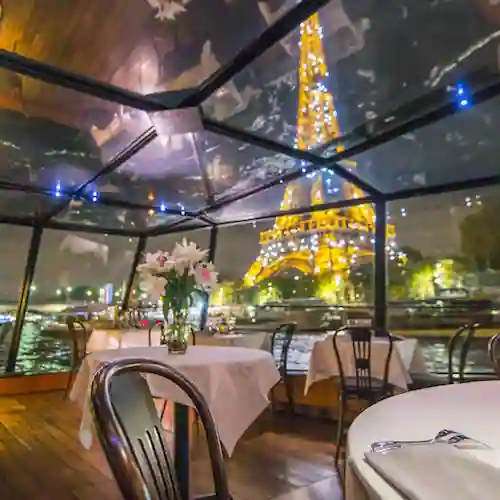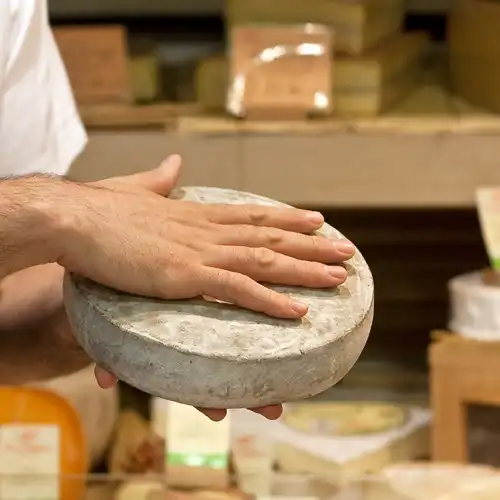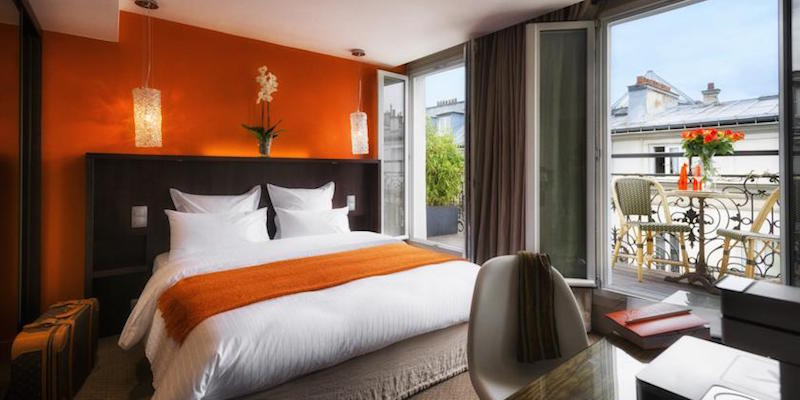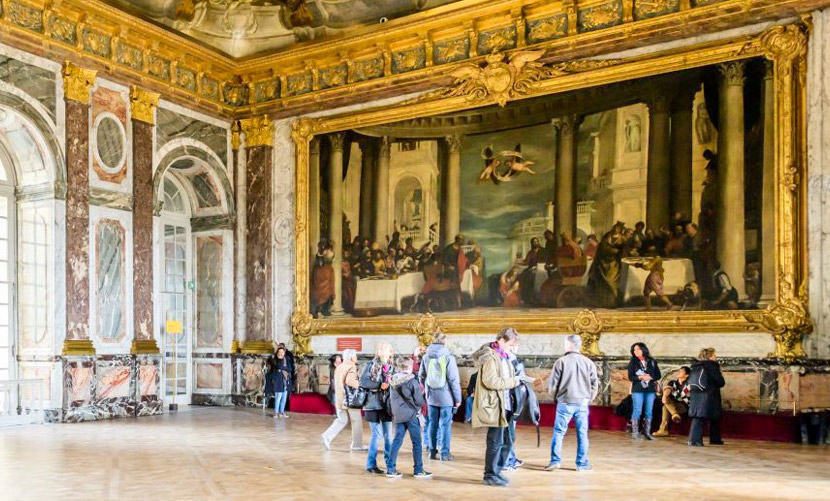Seven Secret Gardens Of The Marais
7 Secret Gardens Of The Marais
Walking the narrow cobblestone streets of the Marais, it's hard to imagine that the district is home to a surprising number of gardens. That's because, from the 12th to the 17th century, the Marais was the favored quartier of the French aristocracy. Behind many of the imposing limestone facades you walk past today, this small elite created courtyards and gardens for their own pleasure. Today, some those luxurious green spaces (or their modern restorations) have become public gardens.
![]()
Discover What's On When You're Here...
• January... |
• February... |
• March... |
• April... |
• May... |
• June... |
• July... |
• August... |
• September... |
• October... |
• November... |
• December... |
Discover What's On When You're Here
• January...
|
• February... |
• March... |
|---|---|---|
• April... |
• May... |
• June... |
• July... |
• August... |
• September... |
• October... |
• November... |
• December... |
1. Jardin Anne Frank
 Jardin Anne Frank, photo Ville de Paris
Jardin Anne Frank, photo Ville de Paris
It's easy to miss this small, secret garden. Access is via Impasse Berthaud, an alley off of busy Rue Beaubourg. Worse yet, when you peer down Impasse Berthaud it looks as if it dead-ends against a building. (In fact, that's what impasse means: dead end.) But, if you persevere you will discover that the alley doglegs to the left to take you to a pretty garden dedicated to Anne Frank.
Appropriately, the garden is attached to Hôtel Saint-Aignan, a classic mansion, which houses the Museum of Art and History of Judaism. (The entrance to the museum is on Rue de Temple.) The garden is sprawling, in a small way; on a map it looks something like a pinwheel.
The Jardin Anne Frank, though relatively recent (2007), preserves the memory of an older layout — the central part, surrounded by a wall, has the same shape as the original garden of the seventeenth century. The historical central garden has been expanded by the addition of two other parcels bought by the City of Paris to create the public garden, which give it its pinwheel-like outline.
By the way, at the end of the impasse, next to the garden, is historic Parisian bistro Le Hangar,, which we write about in this article.
- Address: 71 Rue du Temple
- Access: between 22 & 24 Rue Beaubourg
- Musée d'Art et d'Histoire du Judaisme…
- Garden Information…
2. Jardin Lazare Rachline
 Jardin Lazare Rachline, photo Ville de Paris
Jardin Lazare Rachline, photo Ville de Paris
Surprisingly, this pretty garden in the classic French style was created in the 1980s in the courtyard of Hôtel Donon (built in 1757 and, since 1990, the home of Musée Cognacq-Jay). Even though the garden is modern, it exhibits the classical style with strict geometry and symmetry, bordered by boxwood, geometrically cut. Access is via Rue Payenne, while the entrance to the Hôtel Donon and the Musée Cognacq-Jay is on Rue Elzevir. The mansion itself had been used for commercial purposes for many decades and was in a sorry state until purchased and restored by the City of Paris in 1974.
- Access: 9 Rue Payenne
- Information…
![]()
|
Paris Dinner Cruises on the Seine Dine in style as you glide past the Eiffel Tower, Notre-Dame, and the Louvre on a magical Seine River cruise. Gourmet food, champagne, and Paris lit up at night – it’s unforgettable. |
|
Paris Dinner Cruises on the Seine Dine in style as you glide past the Eiffel Tower, Notre-Dame, and the Louvre on a magical Seine River cruise. Gourmet food, champagne, and Paris lit up at night – it’s unforgettable. |
3. Jardin des Arts – Albert Schweitzer
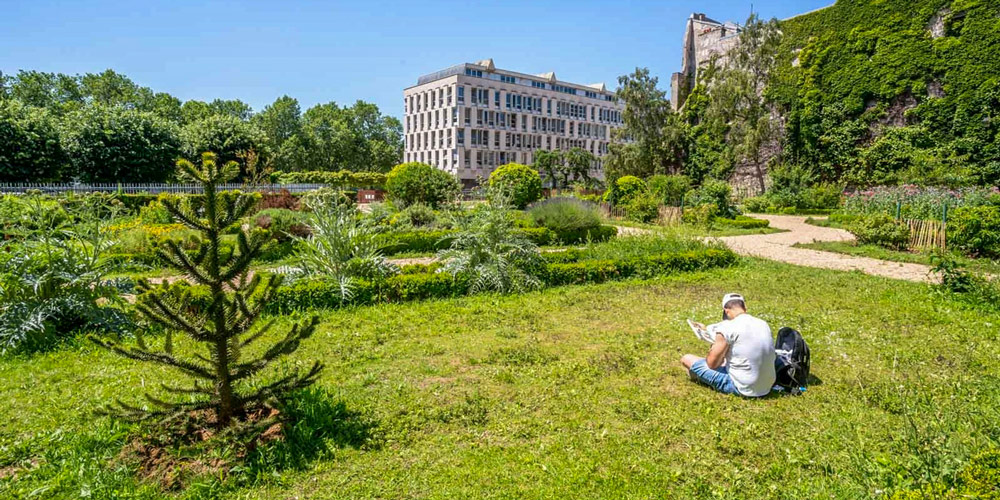 Jardin des Arts – Albert Schweitzer, photo Ville de Paris by Clement Dorval
Jardin des Arts – Albert Schweitzer, photo Ville de Paris by Clement Dorval
Just off the banks of the Seine in the 4th, Jardin des Arts is a composite garden, created by a recent (2020) merging of three green spaces — the garden of the Cité Internationale des Arts (a rather unattractive building facing the Seine), the garden of the Square Albert Schweitzer, and the French garden of the Hôtel d'Aumont, the 17th-century mansion home of the Administrative Tribunal of Paris.
Unlike many Paris parks, visitors are welcome to sit on the lawns here, offering a pleasant resting place after a long walk through the Marais. There are pathways lined with trees as well as a play area for children.
- 10 Rue de l'Hôtel de Ville
- Information…
![]()
|
Taste Your Way Through The Marais Stroll the cobbled streets of the Marais while tasting your way through cheese shops, bakeries, wine cellars, and hidden gems. A local expert leads the way — and keeps the wine flowing. |
|
Taste Your Way Through The Marais Stroll the cobbled streets of the Marais while tasting your way through cheese shops, bakeries, wine cellars, and hidden gems. A local expert leads the way — and keeps the wine flowing. |
4. Jardin des Rosiers – Joseph-Migneret
 Jardin des Rosiers – Joseph-Migneret, photo VIlle de Paris by Christophe Noël
Jardin des Rosiers – Joseph-Migneret, photo VIlle de Paris by Christophe Noël
Here is another three-part and hyphenated-name garden hidden in the Marais. The 2100-sq-m green space was created by merging together the gardens behind three Marais mansions — Hôtel de Coulanges, Hôtel Barbes, and Hôtel d'Albret. Hôtel de Coulanges was built in the early 17th century, in danger of demolition in 1960, and acquired by the City of Paris in 1967 who restored it in 1978.
The first part of the current garden (the Hôtel de Coulanges portion) opened to the public in 2007. In case you're wondering: Joseph Migneret was the director of a school in the Marais who saved several Jewish students during the Nazi Occupation. (165 others were sent to the Nazi death camps, with the cooperation of Vichy authorities.) In the garden is a memorial stele to honor the even younger Jewish children who died in deportation.
- 35-37 Rue des Francs-Bourgeois (Hôtel de Coulanges)
- Alternative access: 10 Rue des Rosiers
- Information…
5. Jardin de l'Hotel Lamoignon – Mark Ashton
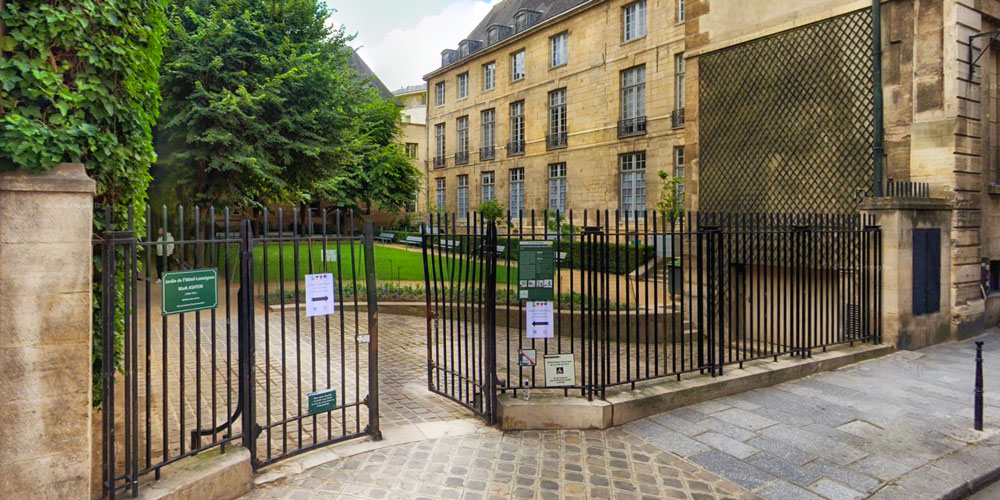 Jardin de l'Hotel Lamoignon, view from Rue des Francs Bourgeois
Jardin de l'Hotel Lamoignon, view from Rue des Francs Bourgeois
We don't know about you, but we've passed this garden (also located on Rue des Francs Bourgeois) many times, so maybe it's not so secret. However, you may not know about the nightly light show here in which a thousand small colored bulbs light up the park, thanks to the work of Véronique Joumard. Even better, the display is recharged during daylight hours with solar panels.
In 2018 the garden's paths and benches were renovated; planters now decorate the terrace. At that time it was re-inaugurated, adding Mark Ashton to its name. Ashton was a a gay rights activist and member of the Communist Party of Great Britain.
- 25 Rue des Francs Bourgeois
- Information…
![]()
|
Browse our hand-picked Paris hotel deals with real-time discounts of up to 20%. Stay in the Marais, Saint Germain, the Latin Quarter, the Left Bank near the Eiffel Tower… every arrondissement is on the list. |
|
Browse our hand-picked Paris hotel deals with real-time discounts of up to 20%. Stay in the Marais, Saint Germain, the Latin Quarter, the Left Bank near the Eiffel Tower… every arrondissement is on the list. |
6. Square Saint-Gilles Grand Veneur – Pauline-Roland
 Square Saint-Gilles Grand Veneur – Pauline-Roland, photo Flickr
Square Saint-Gilles Grand Veneur – Pauline-Roland, photo Flickr
This lovely little park is really hidden, tucked away in the Marais between busy Boulevard Beaumarchais and Rue de Turenne. A rose garden is to be found in this calm oasis that is only accessible from a couple of narrow alleyways. But, once you arrive you can enjoy the serenity of the rose arbor as you relax on a park bench with a lovely view of the rear facade of Hôtel du Grand Veneur (1646).
- Address: 9 Rue du Grand Veneur
- Access: 12 Rue Villehardouin or 5 Rue des Arquebusiers
- Information…
![]()
Our Top-Rated Paris Experiences
7. Jardin des Archives Nationales
 Jardin des Archives Nationales, photo Ville de Paris by Frederic Combeau
Jardin des Archives Nationales, photo Ville de Paris by Frederic Combeau
It's only been a since the late two-thousand-aughts that this 8,000-sq-m garden re-opened to the public. (The gardens were closed following a 1995 terrorist attack in Paris, and remained so for more than a decade.) Such a huge garden in the middle of one of the most bustling quartiers of Paris was made possible by combining the gardens of the Marais mansions that surround it — mansions found on Rue des Archivers, Rue du Temple, Rue des Francs-Bourgeois, and Rue des Quatre-Fils.
Because four gardens were amalgamated, the Jardin des Archives Nationales is itself an amalgam of styles — classic French garden design from the 16th and 17th centuries with plane trees and lawns, a park from the 19th-century Romantic period, even a mini-orchard.
In case you're interested, the four gardens that were combined are: Jardin de l'Hôtel de Rohan (restored in 2008), Jardin des Hôtels d'Assy et de Breteuil (one garden, two mansions), Jardin de l'Hôtel de Fontenay, and Jardin de l'Hôtel de Jaucourt.
- Address: 87 Rue Vieille du Temple, 75003 Paris, Franc
- Access; 60 Rue des Francs-Bourgeois or 11 Rue des Quatre-Fils
- Information…
Paris Planning Guides
 Paris Metro Guide
Paris Metro Guide |
 Left Bank Hotels
Left Bank Hotels |
 Top 10 Food Tours
Top 10 Food Tours |
 Visiting Versailles
Visiting Versailles |
Discover What's On When You're Here• January 2026 Things to Do…• February 2026 Things to Do…• Valentine's Day in Paris…• Month-by-Month Calendar… |




